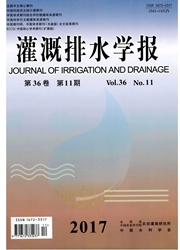

 中文摘要:
中文摘要:
根据1961—2013年我国新疆地区55个气象站常规气象资料,基于Penman-Monteith公式计算了参考作物蒸散量(ET0),并计算其对最高温度、最低温度、风速、日照时数和相对湿度的敏感系数,最后分析了敏感系数的时空变化特征。结果表明,年最高、最低温度呈显著增长趋势,风速、参考作物蒸散量及日照时间呈显著减少趋势。最高温度对ET0敏感性最高,相对湿度次之,而日照时数的敏感性最低。由于气象因子空间分布不均匀,所以新疆敏感系数存在空间分布差异。最高温度、风速和相对湿度的敏感系数在新疆中部及北部较高。最低温度在新疆的西部、东部较高,中部天山山区较低。日照时数在南疆地区较高,北疆地区较低。53年来,最高温度和风速的敏感系数呈减少趋势,其中南疆地区减少趋势明显。最低温度的敏感系数全疆呈增加趋势,在天山山区增加趋势明显,日照时数的敏感系数在南疆地区增加趋势明显,相对湿度的敏感系数在全疆地区呈增加趋势。
 英文摘要:
英文摘要:
The reference evapotranspiration coefficients were calculated using the Penman-Monteith equation based on 55 stations' regular meteorological data from 1961 to 2013 in Xinjiang. Then, the sensitivity coefficients of ETo corresponding with the maximum temperature, minimum temperature, wind speed, relative humidity, sunshine hours were calculated. Finally, the spatial and temporal variations of sensitivity coefficients distribution were analyzed. The results showed that the maximum temperature and minimum temperature had a significant increasing trend, whereas wind speed, sunshine duration and ETo decreased dramatically. In addition, the maximum temperature was the most sensitive variable to ETo and followed by the relative humidity. However, the sunshine duration had the least impact. Due to uneven distribution of meteorological factors, the spatial distribution of the sensitivity coefficient was different. Specifically, the sensitivity coefficient of maximum temperature, relative humidity and wind speed were higher in the middle and north of Xinjiang, while the sensitivity coefficient of minimum temperature was higher in the western and eastern parts of the region, and lower in the middle of Tianshan Mountain. Moreover, the sensitivity coefficient of sunshine duration was higher in the southern Xinjiang and lower in the northern Xinjiang. The sensitivity coefficients of maximum temperature and wind speed indicated the significant decreasing trends in the southern Xinjiang. The sensitivity coefficient of minimum temperature tended to increase in the whole Xinjiang and increased obviously in TianShan Mountain. The sunshine duration indica- ted the significant decreasing trends in the southern Xinjiang and the relative humidity have increased obviously in Xinjiang during the past 53 years.
 同期刊论文项目
同期刊论文项目
 同项目期刊论文
同项目期刊论文
 期刊信息
期刊信息
